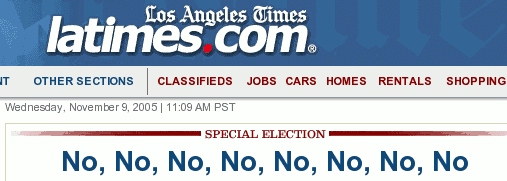Los Angeles County has a new voting system this year. Instead of every registered voter being assigned a specific polling place based on their home address, you can vote at any polling place — excuse me, “vote center” — in the county. There are fewer locations than there used to be, but they’re also open longer for early voting, with locations open the weekend before election day, and some open as many as 11 days ahead.
The idea, as I understand it, is to make it as easy as possible to get to a polling place, no matter what work hours or commute you have to deal with. Hit one near home on your day off, or near work during lunch, or whatever works.
I went in Monday morning for Tuesday’s primary election, figuring the lines would probably be shorter. It was at the local library, and I was kind of amused to see the “Please do not place ballots in book drop” sign, but as expected, there was basically no line. The process was interesting:
- They scanned my sample ballot and printed out a code on an otherwise-blank sheet of paper.
- I took the paper to one of the voting machines and placed it into a feeder slot.
- The machine pulled the paper in and launched the ballot on a touch screen. (The screen was a lot more responsive than the first digital voting machines I used back in the 2000s, where I could actually watch the screen repaint!)
- I chose a language for the ballot.
- I went through each ballot item, one page at a time. The full name/description was a touch target for each option, and once I’d selected a candidate (or yes/no), I pressed another button at the bottom of the screen to go to the next page.
- For items with more candidates than would fit on one screen, “More” buttons would pop up at the top and bottom of the screen. Not ideal, but at least it avoided the accidental-click-while-scrolling problem.
- At the end, it printed out all my choices on the paper and ejected it (with the top edge still in the rollers) so I could look it over.
- I pressed Confirm one more time, and it pulled the ballot back in for storage.
It also had headphones and physical buttons for an audio interface, and there were a lot of volunteers to help voters learn the new system.
It’s probably the most usable balloting system I’ve used. No paddle-wheel or slowly-responding buttons to overshoot with. No lining up generic scantron sheets with the ballot questions and hoping you didn’t position it wrong. No concern that the lever is going to knock over the cardboard voting booth when you punch it (though I do miss the satisfying ka-thunk! of those levers!)
And I really appreciate that the paper trail is not just machine-readable, but human-readable as well! Because that’s the key thing with ballots: it’s more important to be sure that the count is correct than to count it fast. The only way to be sure of that it to have an offline copy that can’t be hacked, like the paper printout. And a sheet of paper with the actual names is much easier to verify than a grid of unlabeled multiple-choice bubbles that you have to line up next to the right options.
Update: With election day come and gone, it’s clear that my good experience was only because I was there early. Countywide, LA reported long lines and people having trouble with the machines. Even at this same location, people waited for hours — in a primary, which normally has lower turnout. Even though there was another station less then a mile away with no line at all. And even though poll workers told them about it!
It’s definitely going to be a good idea to vote early in November, if possible. Update 2: Or just vote by mail, depending on what the Covid-19 pandemic looks like by then.

